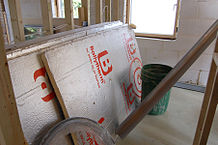U-value

The U-value of insulation is a value that is used to measure how well a specific type of insulation can resist heat flow. The lower the U-value, the more effective the material is at preventing heat transfer.[2] The U-value is very closely linked to the R-value, as it simply represents its inverse. The U-value is also closely connected to the idea of thermal conductivity, which is a property of a material that determines how well it conducts heat. Windows, doors, and skylights all have a specific U-value associated with how well they insulate.
U-values are used more frequently to determine the insulation properties of windows specifically. A U-value is typically a low number as it represents how much heat energy is lost or gained by the window, and thus a low U-value would be more desirable.[3] As well, U-values are typically used in systems where multiple materials are used, such as in windows whereas R-values are used to determine the insulating capabilities of only one material.[3] Low U-factors are most important in heating dominated climates, although they are also beneficial in cooling dominated climates as windows with better insulating properties can resist heat flow more efficiently.[4]
Calculating U-value
When calculating U-value, it is important to know the thickness and area of each building material used so that the total U-value of an assembly can be accurately determined.[2]
Mathematically, U-value is calculating from a measuring heat flow across a surface where each side is at a particular temperature.[5] If the R-value is known, it is more simple to simply calculate the inverse of the R-value to obtain the U-value.[2] However, if it is not known the U-value can be calculated as:
is the temperature difference inside and outside the house in °F
is the area of the wall (or ceiling) that's being insulated in ft 2
is how long the measurement took place in seconds
is how much heat is lost through the wall or window in BTU
References
- ↑ "Polyisocyanurate insulation boards" Licensed under CC BY-SA 2.0 via Wikimedia Commons - http://commons.wikimedia.org/wiki/File:Polyisocyanurate_insulation_boards.jpg#/media/File:Polyisocyanurate_insulation_boards.jpg
- ↑ 2.0 2.1 2.2 RIBA. (April 25, 2015). U-values [Online]. Available: http://www.architecture.com/RIBA/Aboutus/SustainabilityHub/Designstrategies/Earth/1-1-1-10-Uvalues(INCOMPLETE).aspx
- ↑ 3.0 3.1 Norbord North America. (April 25, 2015). Understanding R-value and U-value [Online]. Available: http://www.norbord.com/na/blog/understanding-r-value-and-u-value
- ↑ Energy Efficient Windows. (April 25, 2015). Measuring Performance: U-Factor [Online]. Available: http://www.efficientwindows.org/ufactor.php
- ↑ CIMA. (April 25, 2015). What R-Value Means [Online]. Available: http://www.cellulose.org/HomeOwners/WhatR-valueMean.php

